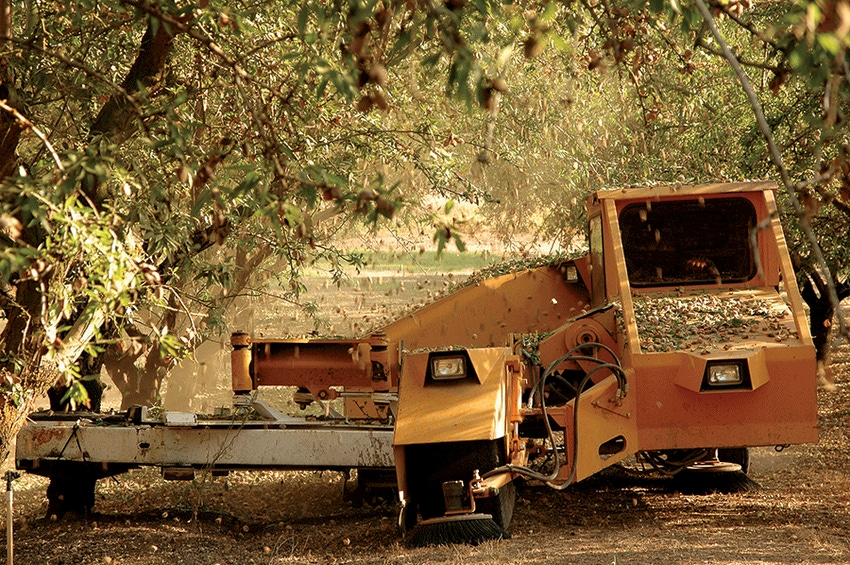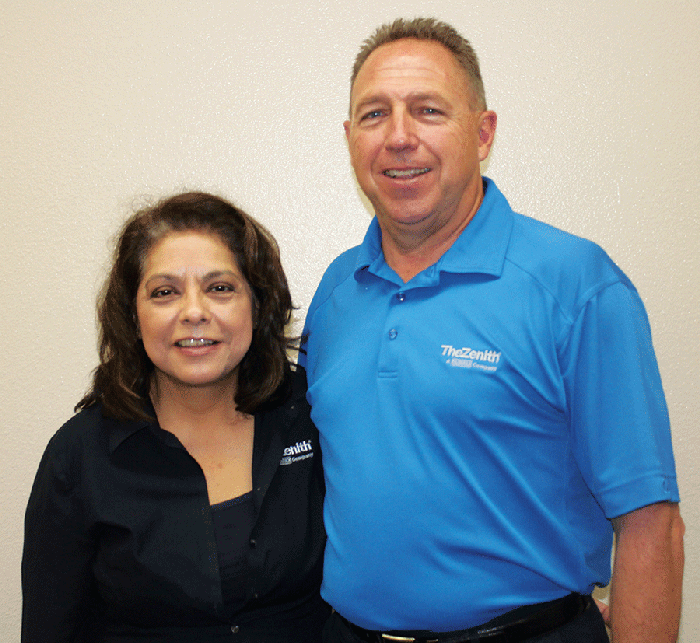August 1, 2018

When it comes to the nut harvest, there are a lot of moving parts: multiple machines that weigh tons and can maim or mangle — shakers, harvesters, reservoir carts, runner shuttles, elevators, truck trailers, forklifts, and aprons that catch pistachios, to name a few.
The machines are loud, and can be dangerous for workers on the ground, who may go unseen because of poor visibility caused by dust and other factors. “People are run over every year,” says Jack Passarella, senior safety and health consultant with TheZenith, a Fresno insurance company.

Sylvia Reyna, ag industry specialist with TheZenith Insurance Co., and Jack Passarella, senior safety and health consultant with TheZenith Insurance Co. (Photo: Dennis Pollack)
Passarella’s discussion was in English, while next door, Sylvia Reyna, also with TheZenith and an ag industry specialist, addressed a group in Spanish on the same topic of nut harvest safety.
Among those in Passarella’s audience was Kam Boparai, a partner in family-run Boparai Farms, which grows almonds, wine grapes, raisins, and cling peaches at Del Rey and Fowler, Calif. With almond harvest then just weeks away, Boparai said he wanted to brush up on tips that Passarella shared. He said he’s been to safety talks before, “but it’s easy to forget after a year passes.”
SAFETY TIPS
Passarella discussed reflective vests and the importance of workers wearing them so they can be seen more easily.
Boparai was impressed with the vest Passarella favors, saying it is light and lets air through. “We also do night harvesting of grapes, and sometimes it’s hard to get workers to wear them,” he says. “It’s an extra layer of clothing.”
Boparai says the training will help him to get across the importance of using a vest. He can now point out that it’s not just his wish — he can cite a training document that shows a picture of the vest, a Class 2 garment, and Passarella’s advice.
Among points made by Passarella:
Miscommunication can be deadly. Some machinery operators have signals to alert those on the ground — perhaps using a horn to signal starts and stops.
Training needs to be done for each piece of equipment. It’s not enough to simply ask if a person can operate the machinery. And any training must be documented.
When operating any piece of machinery, the driver should set the brake and turn it off when exiting the machine.
Machinery should be operated at an established, safe speed. “The biggest hazard is speed,” Passarella says.
Pistachio shakers and aprons are large, powerful machines that can be dangerous to work around. They expand and contract continuously. Passarella told of a worker at Bakersfield who was killed while working under an expanded apron and the apron collapsed after a hydraulic failure.
In addition to adopting a lockout-tagout system when working on equipment, it’s recommended that blockout programs be adopted so there are warnings not to access certain areas around machinery.
Those who service machinery must be trained to do so. “The operator is not a mechanic,” Passarella says.
Road hazards can include clipping guy wires while moving huge machines, and traveling at night (which is defined as from one hour before dusk to one hour after dawn). Machinery should be parked well off the side of the road and made visible to passing motorists.
Pre-shift meetings are required on days when temperatures are to exceed 95 degrees. Crews must have a printed copy of the heat illness prevention plan under which they operate. It must be in the predominant language used by that crew. Heat illness prevention steps start at 80 degrees, with steps that include providing shade and ample water.
Equipment should be inspected before beginning work, using a checklist. Problems and unsafe conditions should be reported to a supervisor. Hazards in the orchard should be marked, and employees should be made aware of them.
Reflective clothing or vests should be required at all times. The cost of a vest is $15 to $30, which is a small price compared to a loss of life or limbs, Passarella says.
Distractions, such as use of cell phones, should be prohibited while on the road.
Never wave vehicles around to pass.
Employees should be warned of any special hazards that exist, including moving along canals or ditches, electrical wires, or bridges.
Extension or other specialty tools should be used during maintenance, service, and repair to ensure that a worker’s body parts are a safe distance from any hazardous exposure. Jams and clogs should not be cleaned or cleared while equipment is in operation.
Lighting should be provided in areas where workers congregate. There have been instances of robberies in the field. Employees should not walk to or from work sites alone. Consider developing a night work safety program.
You May Also Like




